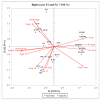Characterization of Sugar Reduction in Model Confectionary Gels Using Descriptive Analysis
- PMID: 36286145
- PMCID: PMC9601666
- DOI: 10.3390/gels8100644
Characterization of Sugar Reduction in Model Confectionary Gels Using Descriptive Analysis
Abstract
Successful sugar reduction in food products mimics the sensory and functional properties of the full sugar counterpart. The initial step of sugar reduction is to determine how the absence of sugar affects these properties. Descriptive analysis was conducted on four gel types (gelatin, ι-carrageenan, κ-carrageenan, and konjac glucomannan) and a range of sugar concentrations from 0-20% w/v to create a sensory profile of model confectionary gels for comparison to instrumental texture profile analysis data. The sensory descriptive data were analyzed using analysis of variance and principal component analysis. Correlation analysis, cluster analysis, and partial least squares regression (PLS-R) were used to compare and correlate sensory and instrumental data. Regardless of sugar concentration, sensory analysis primarily clustered samples by gelling agent type, such as in the case of konjac glucomannan consistently being characterized as chewy. Cohesion and gumminess were correlated highly with melt-in-mouth and a jiggly texture, while adhesion and fracturability were negatively correlated. In the PLS-R samples biplot, gelatin and iota carrageenan samples were located near these attributes indicating their aptness as descriptors. In conclusion, descriptive analysis provided a more discriminating method for characterizing model confectionary gels.
Keywords: carrageenan; descriptive analysis; gelatin; konjac glucomannan; sugar reduction.
Conflict of interest statement
The authors declare no conflict of interest.
Figures






Similar articles
-
Characterization and categorization of commercial confectionary gels through napping-ultra flash profile (UFP) and hierarchical clustering analysis.J Food Sci. 2021 Jun;86(6):2655-2670. doi: 10.1111/1750-3841.15764. Epub 2021 May 20. J Food Sci. 2021. PMID: 34018184
-
Partial removal of acetyl groups in konjac glucomannan significantly improved the rheological properties and texture of konjac glucomannan and κ-carrageenan blends.Int J Biol Macromol. 2019 Feb 15;123:1165-1171. doi: 10.1016/j.ijbiomac.2018.10.190. Epub 2018 Oct 30. Int J Biol Macromol. 2019. PMID: 30385341
-
Linear and Nonlinear Rheology of Mixed Polysaccharide Gels. Pt. I. Young's Modulus, Ring Extension and Uniaxial Compression Tests.J Texture Stud. 2013 Feb;44(1):66-74. doi: 10.1111/j.1745-4603.2012.00366.x. Epub 2012 Jul 31. J Texture Stud. 2013. PMID: 35484800
-
Factors influencing the sensory perception of reformulated baked confectionary products.Crit Rev Food Sci Nutr. 2020;60(7):1160-1188. doi: 10.1080/10408398.2018.1562419. Epub 2019 Jan 22. Crit Rev Food Sci Nutr. 2020. PMID: 30668147 Review.
-
Sugar reduction methods and their application in confections: a review.Food Sci Biotechnol. 2022 Mar 8;31(4):387-398. doi: 10.1007/s10068-022-01046-7. eCollection 2022 Apr. Food Sci Biotechnol. 2022. PMID: 35464251 Free PMC article. Review.
References
-
- Milner L., Kerry J.P., O’Sullivan M.G., Gallagher E. Physical, textural and sensory characteristics of reduced sucrose cakes, incorporated with clean-label sugar-replacing alternative ingredients. Innov. Food Sci. Emerg. Technol. 2020;59:102235. doi: 10.1016/j.ifset.2019.102235. - DOI
-
- Riedel R., Böhme B., Rohm H. Development of formulations for reduced-sugar and sugar-free agar-based fruit jellies. Int. J. Food Sci. Technol. 2015;50:1338–1344. doi: 10.1111/ijfs.12787. - DOI
LinkOut - more resources
Full Text Sources

